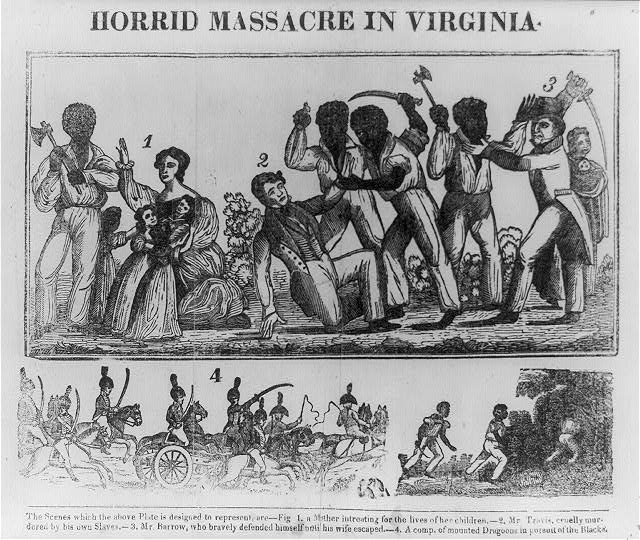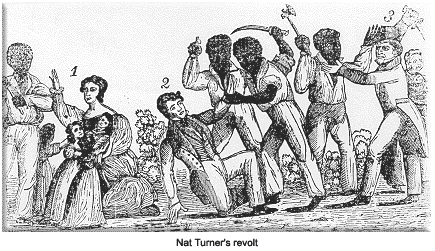Background
“The Confessions of Nat Turner” is Thomas Gray’s pamphlet account of his jail-house interview with Nat Turner, the leader of a two-day slave rebellion in Virginia which started on August 21, 1831, causing the deaths of approximately sixty white men, women, and children. In response to this uprising, white mobs and organized militias attacked black people in the area, killing approximately 120, many of whom were not involved in Turner’s rebellion.
The rebellion caused considerable fear for white slave-owners. This palpable fear caused state legislators to pass new laws to increase control over slaves as well as over freedmen and women.

An 1831 woodcut of Nat Turner’s rebellion
Plot Summary
The pamphlet includes the interview between Thomas Gray and Nat Turner. Much of the story of the rebellion is told by Nat Turner, however, his story is framed by Gray’s opening statement of the event, the results of Turner’s trial, Turner’s obituary, and a list of the names of all of the slaves thought to be involved with the rebellion, attached to a list of their owners and sentencing.
In Gray’s introduction, he highlights the fascination which the public has had for this case, as well as the anxieties which it has inspired. Gray also comments on the fact that everything on the surface appeared calm, despite the fact that rebellion was boiling beneath.
Turner describes his early childhood and his mother’s belief that he had a holy calling due partly to the fact that he was able to remember and describe things that happened prior to his birth. Turner believes that the rebellion was encouraged by God and that he was chosen by God to lead it. He describes the rebellion itself in great detail and makes a point to note that he and his fellow rebels not only killed the white men that they ran into, but also the women, children, and infants. He also describes his master as being kind, but that he still needed to kill the master and his master’s family.
Notes & Quotes
- I wrote a blog post about “The Confessions of Nat Turner” in connection with Melville’s short story “Benito Cerino” last semester for my American gothic independent study. You can find that post here. There are a lot of gothic tropes that Turner employs in his responses to Gray in order to strike greater fear in the white and slave-owning populations. The rebellion itself managed to terrify the white community in Virginia, however, it was this pamphlet that managed to perpetuate the fear beyond Virginia and beyond 1831. My professor, Susan Scheckel, described “The Confessions of Nat Turner” as a sort of “psychic terrorism” performed by Turner during one of our independent study meetings, and I really appreciate and subscribe to this reading. Gray also attempts to use the gothic mode to create fear in his readers, however, it is for a much different reason and it is done less skillfully than Turner. Gray tries to sensationalize the event as much as possible, as well as turn Turner into a sort of inhuman monster, possibly in order to either sell this pamphlet and/or push for increased control of slaves and other black bodies. His writing works to dehumanize Turner and all other black people through the transmission of fear across the reading white population. Turner, on the other hand, utilizes gothic tropes as a form of terrorism and resistance against the white population. While Gray works for the strengthening of slavery, Turner works to end it via a threat of future and continued violence.
